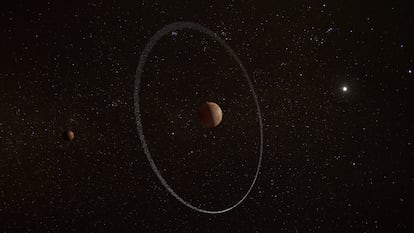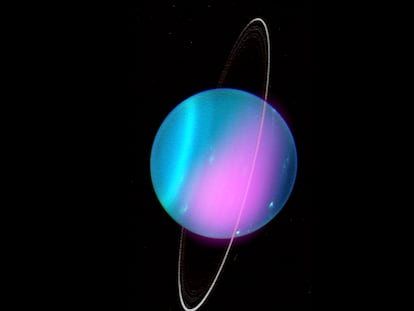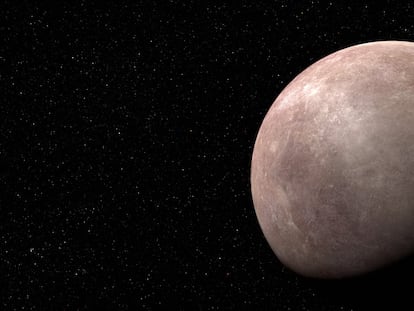The Quaoar ring, Planet X and other mysteries of our solar system
Astrophysicists say planetary rings are like tree growth rings and help us understand a planet’s history

The history of science is full of surprises: planets in unexpected places, gas and stars moving faster than gravity should allow, and galaxies moving when we thought they were stationary. New data has led to new paradigms: the universe is expanding, planets migrate, and there is more mass than is visible under light. New measurement technologies have enabled us to formulate new theories that advance human knowledge.
Science has also gifted us little gems once thought impossible until we saw them for the first time. From time to time, unique and peculiar objects are discovered that may not alter the course of science or our concept of the universe, but that force us to consider new possibilities. These are the discoveries that theorists like me enjoy the most. They demonstrate realities that could not be and force us to question what we know, change our thinking, and ponder what we missed in our models. One such discovery is the Quaoar ring.
Quaoar is a minor body in the Solar System, but it is not a planet, a dwarf planet or a satellite. It is one of the many objects like asteroids and comets orbiting beyond Neptune, the most distant planet in the Solar System. There are about 50,000 such objects, and we didn’t even know Quaoar existed until 2002. It was named after the Great Creator of the Tongva people, ancient inhabitants of the southern California coast.
Quaoar is about the size of the Iberian Peninsula if rolled into a ball. Its 345-mile (555-kilometer) radius is slightly smaller than the Earth’s newly discovered iron core. It also has a moon called Weywot that is just 50 miles (80 kilometers) in radius and orbits Quaoar at a distance of 8,276 miles (13,320 kilometers). This is close – about the same as the distance between California and Australia. Quaoar also has a recently discovered planetary ring, which is surprising for such a small body. It’s the third such ring around a small body in the Solar System – Centaur Chariklo and Haumea have the other two. But this ring is not where you would expect it to be.
A planetary ring is a disk formed by tiny pieces of ice and other material orbiting a larger object. The most well-known examples are Saturn’s rings, but the four giant planets in the Solar System – Saturn, Neptune, Uranus and Jupiter – all have them. The ones around Neptune and Jupiter are so faint that they are difficult to see and were first observed when the Voyager space probe passed by.
The location of planetary rings is fundamental to understanding them. All the ones observed so far are within the Roche limit of their central bodies – the distance from a celestial body within which a second celestial body, held together only by its own force of gravity, will disintegrate. In other words, the material in the rings is held together by the central object’s gravity, which continually breaks up chunks of material and inhibits the formation of moons.
The Quauar ring is beyond that critical distance by 2,500 miles (4,100 kilometers). At that distance from the central object, the particles in the ring should collide and stick together because the attraction between the ice chunks is greater than the central gravitational force. The ring is dense and narrow, meaning there are enough collisions to form moons within a few decades. At least, that’s what we thought.
Planetary rings represent a historical record and something more prosaic – colliding pieces of ice perhaps agitated by the existence of a moon. Pure beauty in disc form. The ability to see Quaoar’s ring from far away means that other processes are causing the material not to accrete and form moons. The planetary ring of Quaoar is too narrow and small to be detected directly. To see it, one has to use a technique of multiple telescope occultations that measure how the light from Quaoar attenuates starlight as it passes in front of it. Spain’s GRANTECAN telescope and high-speed HiPERCAM camera played a leading role in this process since the occultation lasts less than a minute.
One theory to explain the existence of the Quaoar ring is to assume that the particles are affected by external gravitational pushes that cause them to collide at high velocities, which is why they don’t bond and grow. These external gravitational pushes are known as resonances and may be caused by undiscovered moons or by Weywot, Quaoar’s known moon. This phenomenon is not new and has led to the discovery of other planets. Recent data on peculiar orbital patterns in objects beyond Neptune have some scientists theorizing that a new planet – Planet X – may be lurking in the Solar System’s outer reaches.
Sign up for our weekly newsletter to get more English-language news coverage from EL PAÍS USA Edition
Tu suscripción se está usando en otro dispositivo
¿Quieres añadir otro usuario a tu suscripción?
Si continúas leyendo en este dispositivo, no se podrá leer en el otro.
FlechaTu suscripción se está usando en otro dispositivo y solo puedes acceder a EL PAÍS desde un dispositivo a la vez.
Si quieres compartir tu cuenta, cambia tu suscripción a la modalidad Premium, así podrás añadir otro usuario. Cada uno accederá con su propia cuenta de email, lo que os permitirá personalizar vuestra experiencia en EL PAÍS.
¿Tienes una suscripción de empresa? Accede aquí para contratar más cuentas.
En el caso de no saber quién está usando tu cuenta, te recomendamos cambiar tu contraseña aquí.
Si decides continuar compartiendo tu cuenta, este mensaje se mostrará en tu dispositivo y en el de la otra persona que está usando tu cuenta de forma indefinida, afectando a tu experiencia de lectura. Puedes consultar aquí los términos y condiciones de la suscripción digital.
More information
Archived In
Últimas noticias
Most viewed
- Reinhard Genzel, Nobel laureate in physics: ‘One-minute videos will never give you the truth’
- Oona Chaplin: ‘I told James Cameron that I was living in a treehouse and starting a permaculture project with a friend’
- Pablo Escobar’s hippos: A serious environmental problem, 40 years on
- Charles Dubouloz, mountaineering star, retires at 36 with a farewell tour inspired by Walter Bonatti
- Why we lost the habit of sleeping in two segments and how that changed our sense of time











































